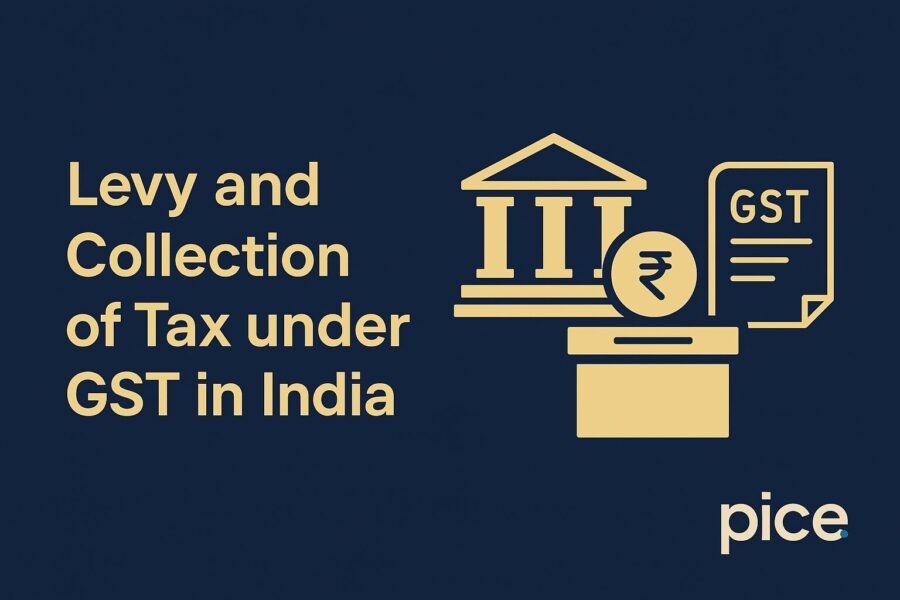Levy and Collection of Tax under GST in India
- 13 Nov 25
- 10 mins

Levy and Collection of Tax under GST in India
Key Takeaways
- India collected ₹20.14 lakh crore GST in FY 2023–24, showcasing its power as the backbone of India’s revenue system.
- GST operates through CGST, SGST, and IGST, balancing tax revenue between the Centre and the States.
- GST is levied on the transaction value of goods and services, ensuring transparency in taxation.
- IGST directs tax revenue to the consuming state, promoting fairness and regional balance.
- GST simplifies indirect taxation, replacing multiple taxes with one unified structure across India.
Curious how ₹20.14 lakh crore was collected under Goods and Services Tax in FY 2023–24 alone? The levy and collection of GST in India play a vital role in powering the nation’s economy, funding roads, schools, healthcare, and more.
But who collects what, and how is it shared? With three layers available - Central GST (CGST), State GST (SGST), and Integrated GST (IGST) - the GST framework of India balances revenue between the government and the States.
Whether you are a business owner, student, or curious citizen, this article discusses the entire process in simple terms, making it easier for you to understand where your tax money goes and why it matters.
How is GST Levied in India?
In India, the government is responsible for the levy and collection of tax under GST on the supply of goods and services under a dual structure, CGST and SGST on intrastate supplies and IGST on interstate supplies.
As per Section 9 of the GST Act, the Centre recovers CGST, the States recover SGST, and the Centre and States share IGST. Furthermore, the tax is payable on transaction values as defined under GST legislation.
Here is a more detailed discussion of how GST is levied under CGST, SGST and IGST:
Central Goods and Services Tax (CGST)
The Central Government imposes the CGST on intra-state suppliers of goods and services. The CGST Act governs this type of tax, which applies to all taxable supplies other than alcoholic liquor intended for human consumption.
The GST Council suggested a rate based on the transaction value, fixed under Section 15 of the CGST Act. This rate is capped at 20%.
Reverse Charge Mechanism (RCM) is one of the most important mechanisms in CGST. The person receiving goods and services in reverse charge is now responsible for paying the GST. It mainly concerns commissioned-to-notified supply transactions or notified services.
Furthermore, it facilitates an expansion of the tax base by covering transactions that occur in the informal sector.
It is important to note that, currently, petroleum products are not subject to CGST. Such products include:
- Crude oil
- Petroleum crude
- High-speed diesel
- Natural gas
- Aviation turbine fuel
- Motor spirit
They have been added with conditions awaiting subsequent notification per the advice of the GST Council.
Example: A company in West Bengal offers its services with a value of ₹8,000 within the state, and the GST rates applicable are 18% (9% CGST + 9% SGST); the amount of CGST collected is ₹720. This money is remitted to the Central Government, responsible for the levy and collection of tax under GST.
State Goods and Services Tax (SGST)
State Goods and Services Tax (SGST) levied by individual state governments covers the importance of the intrastate supply of goods and the supply of services. This tax system is guided by its legislature in the form of the SGST Act, 2017, which is unique to every state.
Therefore, this tax is equivalent to CGST and is uniform across the country from the standpoint of both tax rates and tax collections. The system is uniform because the amount of CGST to be charged on transactions is the same as the value of SGST.
Where there is any intrastate supply, the government levies CGST and SGST together. The Central and state governments equally share the total GST collected. This taxation mechanism assists the two governments in deriving revenue and compliance costs from activities that take place within the territorial boundaries of the state.
States get SGST revenue as a source of funding for growth projects, health, education and welfare initiatives. Moreover, the harmonisation of the SGST and CGST will allow businesses to abide by a single rule set and pay taxes to the central and state governments.
Example: Ms. A is a retailer in the state of Maharashtra and sells goods of ₹10,000 within that state. If the applicable GST rate is 18%, SGST collected will be ₹900, and CGST collected will be ₹900. The amount of SGST goes to the Maharashtra State Government, and they can enjoy the economic activity that is going on in their district.
Integrated Goods and Services Tax (IGST)
IGST is used in inter-state transactions for the levy and collection of tax under GST between the states, imports, and exports. The Central Government imposes it through the IGST Act, 2017 and facilitates a coherent process of taxing supplies that pass across state lines.
Moreover, IGST aims to ensure that the destination state receives tax revenue from goods or services consumed there, promoting a fair geographical distribution of resources.
The GST Council recommends that the IGST rate be calculated based on the supply value. Furthermore, the highest rate that IGST would apply can rise to 40%. India imposes IGST on the import of goods and the import of services into India. Exports are zero-rated under GST.
The money received in the form of IGST because of the levy and collection of tax under GST goes to the Central Government, which in turn transfers this amount to the destination state. Hence, this will make the tax burden based on the pattern of consumption rather than on the place of origin of supply.
Example: A business in Ahmedabad sells goods of ₹1,00,000 to a customer in Pune. The GST charged is 18% and so the rate of IGST is ₹18,000. The Central Government pays this sum, which is shared with the Maharashtra Government, the state that is consuming it.
How to Collect GST in India?
As per the provisions in Section 5, the GST mechanism in India is systematic to make tax collection transparent, accountable and easy flow of revenue to the government. Here is the collection process of tax revenue from GST in India:
Tax Invoice
GST levies the supply of goods and services in India under the CGST, SGST, and IGST Acts of 2017. The authorities impose the tax depending on the type of supply, intrastate or interstate. They impose CGST and SGST on intrastate supplies, and they impose IGST on interstate supplies.
Returns Filing
Businesses pay monthly, quarterly and annual returns of GST depending on their turnover and type of registration. These returns explain the out and inward supplies, tax collected, and the input tax credit (ITC) claimed, which assist the government in monitoring GST compliance.
Tax Payment
Individuals make online payments of GST through the GST portal. Taxpayers are eligible to use ITC to reduce their liability. You will be required to pay a net amount of tax after applying eligible credits.
E-Way Bill
Governments require electronic waybills for goods exceeding a certain value to be transported. This assists in monitoring goods in transit and eliminates tax evasion.
What are the Benefits of Collecting GST in India?
The levy and collection of tax under GST have many important economic benefits to businesses and the general economy of India. Here are certain benefits of collecting GST in India:
Liberalisation of Tax Structure
GST helps in the replacement of various indirect taxes with a single tax, which implies that compliance is easier and has much less administrative cost.
Cancellation of Tax Cascading
Under the input tax credit system, businesses do not pay income tax, resulting in a lower effective taxation burden.
Formation of a Common Market
GST integrates India’s market, which helps to trade easily across states and increases operational efficiency.
Greater Efficiency in Revenues
GST has made major positive changes to collect taxes by increasing the tax base. Therefore, proper enforcement of the levy and collection of tax under GST is ensured for better tax compliance.
What are the Drawbacks of Collecting GST in India?
Although GST has rationalised the indirect tax system in India, the general issue of the levy and collection of tax under GST remains a drawback. Here are the different drawbacks of collecting GST in India:
Complex Multiples and Compliance
The complexity of GST rules and the regularity of filing returns require constant updates and professional assistance. This proves to be a problem for businesses, particularly small and medium-sized businesses.
Effect on the Prices
GST has changed the pricing mechanism, and there is a fear of inflation and high consumer prices in some industries.
Technological Infrastructure
Effective collection of GST requires using the GSTN portal, which has previously experienced technical difficulties that led to delayed filings and payments.
Inter-State Coordination
The coordination amongst states in sharing IGST becomes an important issue. It may impact the transfer of funds involved.
Conclusion
GST has certainly changed, bringing in a new system of taxation in India and providing a single market with limited efforts on tax collection. However, the levy and collection of tax under GST needs constant enhancement of compliance, technology, and interstate coordination.
Although the advantages of GST are high, there is a need to deal with challenges to make it successful in the long run. Through a sustained reform process, the government can use GST to boost the economy, improve transparency, and strengthen India’s fiscal structure.
💡If you want to streamline your payment and make GST payments via credit, debit card or UPI, consider using the PICE App. Explore the PICE App today and take your business to new heights.
 By
By 















